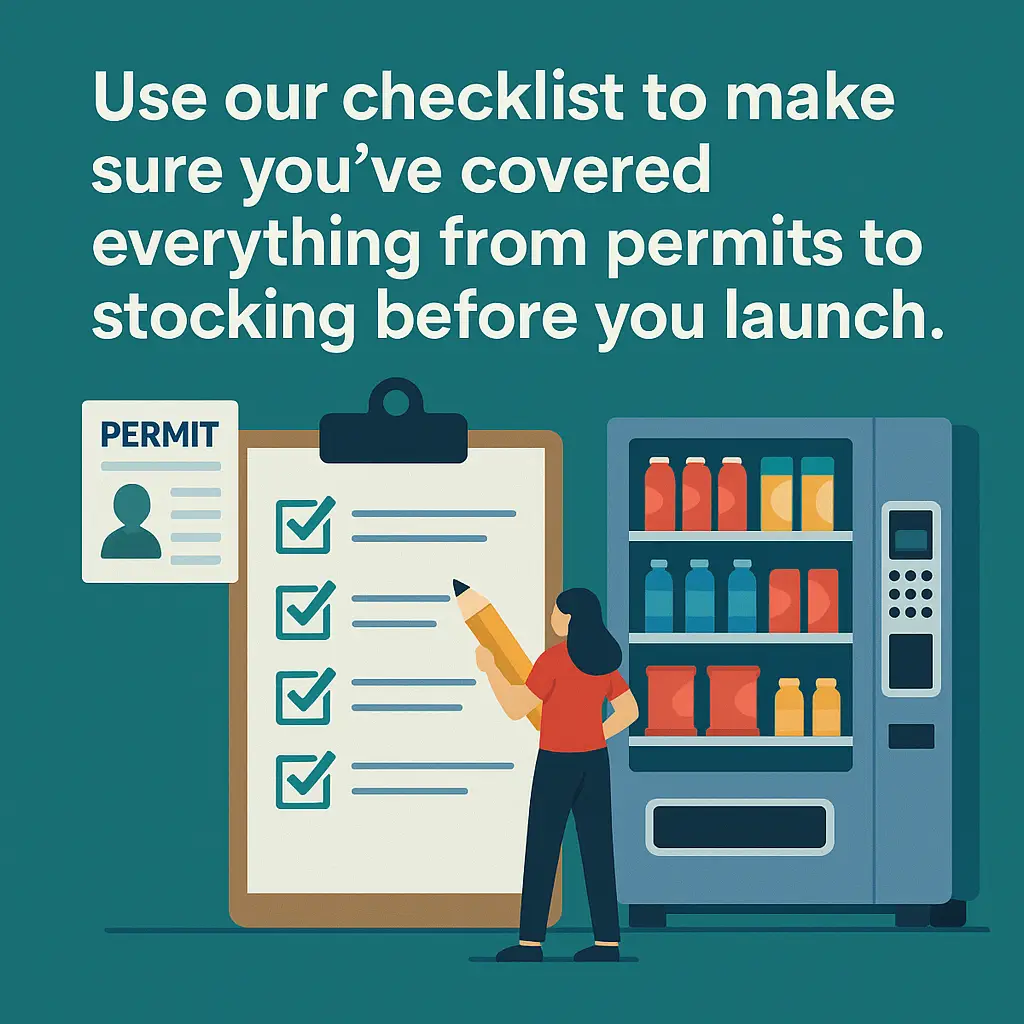Vending Business Startup Checklist
Use our checklist to make sure you’ve covered everything from permits to stocking before you launch.
Back to Vending Business Startup ResourcesUse our checklist to make sure you’ve covered everything from permits to stocking before you launch.
Back to Vending Business Startup ResourcesStart your 30-day free trial and get instant SMS and email alerts whenever a local business needs vending service. These are real location leads to help you grow your route — you decide which ones to buy, no obligations or contracts.
![]() Business licenses and permits are often required by state and city
Business licenses and permits are often required by state and city
![]() Choosing high-traffic locations boosts initial vending income
Choosing high-traffic locations boosts initial vending income
![]() Stock smart: popular snacks outperform niche items early on
Stock smart: popular snacks outperform niche items early on
30 days free, then $39 / month.
No Commitment. Cancel Anytime.

Starting a vending machine business can be a profitable venture, but only if you're prepared. This startup checklist walks you through key components needed to launch successfully.
1. Legal and Administrative Tasks: Begin by selecting a business name and registering your company. Most states require a business license or seller’s permit—check with your local jurisdiction. Also secure a federal EIN if you plan to open a business bank account or hire contractors.
2. Location Strategy: Securing the right spots is critical. Look for high-foot-traffic areas such as offices, apartment complexes, schools, or gyms. These locations often yield steady vending traffic. Make sure to have an agreement in writing that covers terms, service frequency, and exclusivity rights. Learn more about protecting your vending rights through exclusivity.
3. Equipment Selection: Choose the right type of vending machine based on your audience. Combo machines are great for small breakrooms, while glass-front machines offer better visibility in larger spaces. Smart vending units with contactless payment options are increasingly in demand due to convenience.
4. Inventory Planning: Stock a mix of popular and healthy snacks, drinks, and energy items. Test your inventory to see what sells. Use expiration logs and plan rotation schedules to avoid spoilage, which can damage your business’s reputation.
5. Maintenance and Servicing: Have a plan for regular machine checks and servicing. Broken vending machines or poor restocking service can get you removed from a location. Consider smart vending tools or remote monitoring to reduce downtime.
6. Tracking Location Opportunities: Use mapping tools, location databases, or field research to find new placement options. Our guide to tracking potential vending locations is a helpful starting point.
7. Marketing and Lead Generation: Create a simple website or social media page. Promote your brand to local businesses. Good service and clean, stocked machines often lead to referrals.
Vending Exchange connects vending operators with real businesses actively looking for vending services—including traditional machines, AI coolers, and office coffee. Get instant SMS and email alerts when new opportunities are available in your area. No contracts or monthly fees—just buy the leads you want. Start your free 30-day trial today and grow your vending business on your terms.
You typically need a local business license, a sales tax permit, and possibly a vending-specific license. Requirements vary by state and city.
Look for high-traffic areas with hungry or thirsty consumers: offices, gyms, schools, apartment complexes, and factories are ideal.
Combo machines are versatile for beginners. You might also consider snack-only or drink-only machines depending on location demand.
Yes, general liability insurance helps cover equipment damage, product liability, or site-related accidents.
Start with bestsellers: name-brand chips, water, soda, energy drinks, and a few healthy options to test the market.
Check machines frequently, respond quickly to service issues, rotate stock, and monitor inventory and coin jams regularly.
Use smart vending software if available. Otherwise, log manual inventory changes after each restocking trip to spot trends.
Yes. Most consumers today prefer contactless options. It's a small investment that boosts convenience—and sales.
Use online tools, local networking, or partner services like Vending Exchange to access verified, high-interest location leads.
Expect upfront equipment costs ($2,000–$5,000 per machine), inventory, licensing, transportation, and initial marketing expenses.